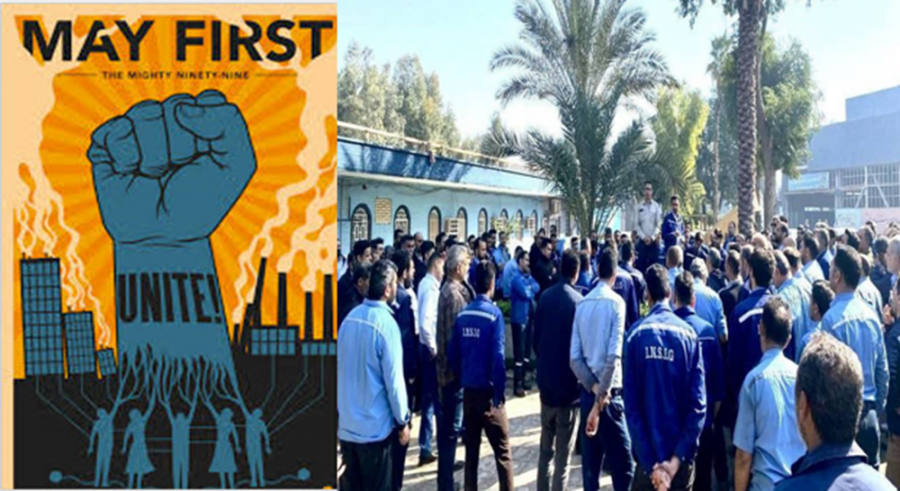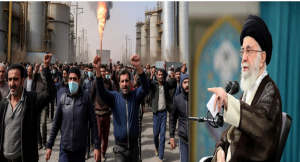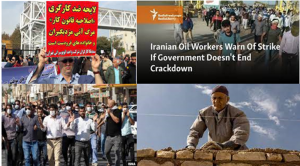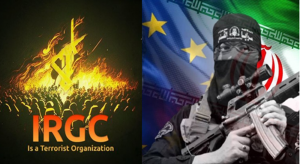
(Video) Iranian Workers’ Struggle for a Free Iran
In contrast to Khamenei’s plush statements about the working class in Iran, it is sufficient to pay attention to the workers’ resolutions on April 30 each year.
PARIS, FRANCE, May 2, 2024 /EINPresswire.com/ -- The National Council of Resistance of Iran (NCRI) Foreign Affairs Committee in an article reported that May Day, celebrated globally as a symbol of worker solidarity, carries profound significance for Iranian laborers, who have endured unparalleled adversity over the past year. Alongside teachers, students, nurses, farmers, retirees, and others, workers in Iran have faced formidable challenges, highlighting systemic issues plaguing the nation’s workforce.
Poverty and Unemployment
Iran’s economy grapples with soaring inflation rates, reaching a staggering 63.9 percent, the highest in half a century. This economic turmoil has precipitated a drastic increase in poverty levels, with the number of individuals living below the poverty line surging from 16 million to over 26 million within just four years.
The repercussions are felt across society, exacerbating existing inequalities as the middle class slides into poverty while the wealthy remain insulated.
Unemployment compounds the nation’s woes, exacerbated by reactionary policies such as the closure of commercial and service centers for non-compliance with compulsory hijab regulations. Shockingly, over half of tourism establishments faced closure due to this mandate.
Necessities become increasingly inaccessible, with food inflation surpassing 50 percent, marking an 80-year high and further burdening already struggling households.
The Plight of Retirees
Iran’s retirees, numbering approximately 26 million, find themselves mired in dire circumstances exacerbated by the collapse of 15 out of 17 pension funds due to rampant mismanagement and corruption.
Their demands for fair treatment, including salary adjustments commensurate with real inflation rates and the implementation of pension synchronization, remain unheeded. The government’s skewed budget priorities, allocating double the revenue from taxes compared to oil, underscore its negligence towards retirees’ welfare.
The Migration Crisis and Nurses’ Struggles in Iran
Nurses, indispensable to Iran’s healthcare system, endure punishing work conditions and meager salaries, with many of their demands left unaddressed.
Severe shortages, estimated at 70,000 nurses, exacerbate the crisis, prompting protests against inadequate tariffs, delayed payments, and excessive workloads. The phenomenon of migration, both domestically and internationally, compounds the issue, with thousands of nurses seeking better opportunities abroad due to untenable conditions at home.
The Persistence of Struggle
Over the years, various segments of the Iranian populace, including workers, employees, and educators, have come to a clear realization. As long as the current regime remains in power, they will continue to be deprived of their fundamental rights.
Consequently, they join other sectors of Iranian society in advocating for the overthrow of this regime and the establishment of a democratic republic.
This envisioned republic would empower citizens to elect genuine representatives and uphold their paramount right to freedom. Recent uprisings have underscored the readiness of the Iranian people for such change.
Although initially triggered by economic or livelihood grievances, protests swiftly evolve into political demands, epitomized by chants such as “Death to Khamenei” and “Death to the dictator.” These shifts reflect the underlying volatility within Iranian society.
Observing Labor Day by standing in solidarity with Iranian workers extends beyond mere expressions of sympathy; it entails actively endorsing their aspirations, foremost among them being the downfall of the current regime.
Concrete steps toward this goal include advocating for the designation of the Islamic Revolutionary Guards Corps (IRGC), the regime’s principal tool for repression and terrorism, as a terrorist organization.
Additionally, it involves lending support to and acknowledging the courageous resistance efforts of the Iranian people and their grassroots movements, particularly the Resistance Units, in their ongoing struggle against the IRGC’s oppressive grip.
In Shush, southwest Iran, workers of the Pars Paper factory have entered their eleventh day of strikes and protests in front of the Shush governorate. This protest comes as 12 workers have been summoned to security and judicial authorities.
Over 800 workers of the Pars Paper factory demand the removal of contractors, adjustment of workers’ wages to match those of companies in the region, full operation of production lines, elimination of discrimination, job security, and improvement of working conditions and benefits.
The workers’ protests began on the first day of April and escalated after the closure of some production lines and the dismissal of around 100 workers. These protests prompted the employer to agree to reinstate dismissed workers. However, recent reports suggest that 12 workers have been summoned to judicial and security authorities on the eve of International Workers’ Day, May 1.
Instances of workers being dismissed or facing security and judicial actions due to their protests against living conditions have been reported in various regions of Iran in recent years.
Meanwhile, in Isfahan, central Iran, gold merchants continue their strikes in protest against new legislation imposing heavy taxes on their sales.
The protests and strikes by workers in various parts of Iran have expanded in recent years. Among the issues raised by protesters are low wages, unpaid wages and benefits, layoffs, and privatization.
Social media reports indicate that at least two participants in a retirement pensioners and teachers’ rally in Ahvaz on Tuesday, April 30, were detained by the authorities after the gathering.
Retirement pensioners’ associations have identified the detainees as Ahmad Nochian, a retired teacher, and Mohammad Zaman Kamrava, a retired pensioner. Some of these associations also mentioned that Ahmad Nochian’s spouse was also detained by Ahvaz Intelligence Bureau officials.
Khamenei’s delusional remarks on the conditions of Iranian workers
On April 24, at the cusp of International Workers’ Day, Iranian regime supreme leader Ali Khamenei spoke so passionately about labor issues in Iran from his ivory tower as if Iranian workers were living in luxury and abundance, and only the “leap in production” remained. He said, “The cornerstone of the leap in production is the worker.”
Hearing Khamenei’s words, it’s hard to believe that these statements are coming from the leader of a country where, according to the report of Iran’s Statistical Center, 60% of its people are below the poverty line.
Khamenei speaks as if he does not know the real situation of Iranian workers. He is aware of the dire situation of the working class, employees, teachers, and wage earners. However, following the tradition of all dictators, the fundamental political and economic problems between the people and the regime are covered up and censored, and an efficient image of the ruling regime is promoted.
Khamenei did not mention the skyrocketing prices of essential goods and commodities that have burdened many Iranian workers, forced their children out of education and into labor, compelled workers to take on multiple jobs, and even pushed some to migrate.
He has exploited the people to the bone, and now he demands their participation in production, following the deceptive traditions embedded in the regime. He said, “The leap comes with people’s participation. If people enter the field of economy, especially the field of production, the leap in production will occur.”
Khamenei fails to acknowledge that the nation is trapped in a quagmire of economic crisis, livelihood hardships, and unemployment due to the regime’s policy of totalitarianism. His statements reflect a state of delusion:
“When production leaps, the country becomes wealthy, the masses become rich, the worker’s pockets fill, the worker’s hand is full, employment increases, unemployment decreases, and the numerous problems of workers and the economy in the country vanish.”
He talks about “people’s participation,” but he fails to acknowledge that even according to manipulated government statistics, over 60% of the Iranian people actively participated in boycotting and rejecting the clerical regime’s sham elections in February of last year. This level of participation couldn’t be clearer in expressing their dissatisfaction with the corrupt regime.
The attendees in Khamenei’s session are not genuine representatives of Iranian workers, but rather hand-picked individuals appointed by the regime in factories and workshops.
That is why in the past 45 years, there has been no mention of the presence of any independent labor unions or syndicates in the meetings of the ruling regime in Iran. The regime has systematically suppressed independent worker organizations and unions, preventing genuine representation of the workers’ interests.
The participants in Khamenei’s session bear no responsibility for improving the situation of Iranian workers because there is no representative from any workers’ organization present in this session.
It is a common practice among dictators to have individual recipients who have no collective power or organized representation, ensuring that they remain powerless and unable to demand their rights through collective action and organization. This tactic aims to prevent any meaningful change or improvement in workers’ conditions.
In contrast to Khamenei’s plush statements about the working class in Iran, it is sufficient to pay attention to the workers’ resolutions on April 30 each year.
These resolutions are filled with reports of months-long delayed wages, marginalization, impoverishment, unemployment, livelihood deprivation, and the exploitation of workers. They also expose the workers and labor unions to the regime’s forces.
Khamenei, in describing the most crisis-ridden class of wage earners, makes deceitful claims that “everything is fine and normal.” What Khamenei fears and strives to conceal through his delusional statements is the accumulation of anger and resentment among the working class and the exploited sectors of Iran.
They possess the broadest and strongest potential for a comprehensive uprising and revolution, aimed at dismantling the rule of exploitative and deceitful authority.
If you wish to receive the NCRI weekly Newsletter, please use the following link to subscribe: https://bit.ly/3SMgEla.
Shahin Gobadi
NCRI
+33 6 61 65 32 31
email us here
This statement is coming from the leader of a country where, according to the report of Iran’s Statistical Center, 60% of its people are below the poverty line.
EIN Presswire does not exercise editorial control over third-party content provided, uploaded, published, or distributed by users of EIN Presswire. We are a distributor, not a publisher, of 3rd party content. Such content may contain the views, opinions, statements, offers, and other material of the respective users, suppliers, participants, or authors.






